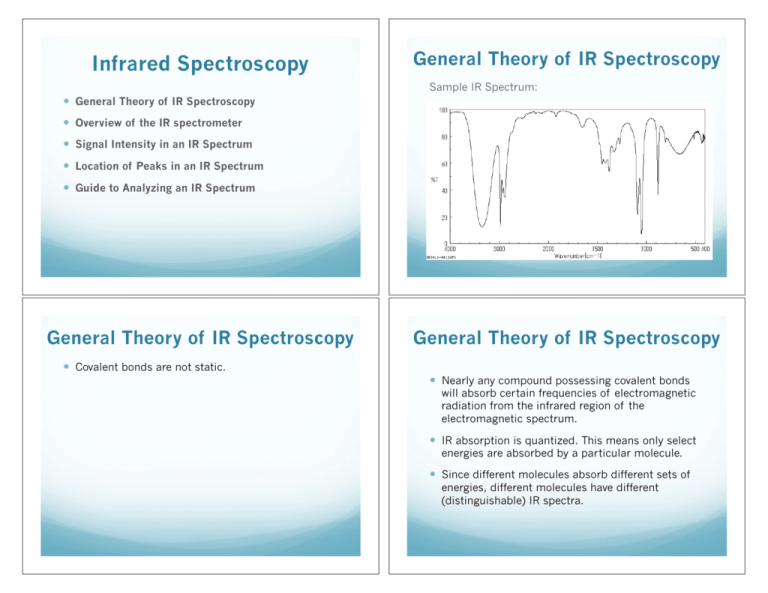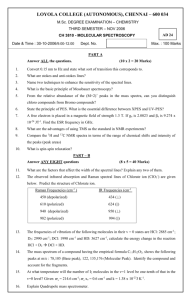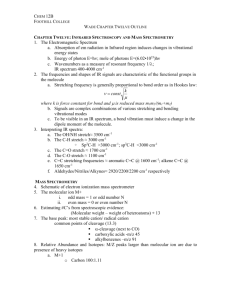here
advertisement

Infrared Spectroscopy General Theory of IR Spectroscopy Sample IR Spectrum: ! General Theory of IR Spectroscopy ! Overview of the IR spectrometer ! Signal Intensity in an IR Spectrum ! Location of Peaks in an IR Spectrum ! Guide to Analyzing an IR Spectrum General Theory of IR Spectroscopy General Theory of IR Spectroscopy ! Covalent bonds are not static. ! Nearly any compound possessing covalent bonds will absorb certain frequencies of electromagnetic radiation from the infrared region of the electromagnetic spectrum. ! IR absorption is quantized. This means only select energies are absorbed by a particular molecule. ! Since different molecules absorb different sets of energies, different molecules have different (distinguishable) IR spectra. General Theory of IR Spectroscopy General Theory of IR Spectroscopy ! Absorption of IR energy causes excitations in the vibrational motions of molecules. OH O General Theory of IR Spectroscopy General Theory of IR Spectroscopy Normal modes of vibration = stretching and bending animation General Theory of IR Spectroscopy Overview of the IR spectrometer Fourier Transform infrared (FT-IR) spectrometer: Overview of the IR spectrometer Our IR spectrometer contains an Attenuated Total Reflectance (ATR) accessory. Signal Intensity in an IR Spectrum For a bond to absorb in IR, there must be a change in the dipole moment during the vibration. If a bond is non-polar due to symmetry, IR light will not be absorbed and the vibration is said to be IR inactive. symmetry H 3C C C is IR active CH 3 C C is IR inactive Signal Intensity in an IR Spectrum Signal Intensity in an IR Spectrum A more polar bond will have a stronger absorption than a less polar bond. C C O C Signal Intensity in an IR Spectrum An alkene C=C stretch generally appears ~1650 cm-1. Location of Peaks in an IR Spectrum Two General Regions in an IR Spectrum: 1-heptene 3-heptene > 1400 cm-1 Functional Group Region < 1400 cm-1 Fingerprint Region Location of Peaks in an IR Spectrum More Specific Regions in an IR Spectrum: 4000 cm-1 2500 2000 1500 Location of Peaks in an IR Spectrum Some factors affecting peak location: 1000 400 1. Mass of the atoms: The stretching frequency of a bond connected to a lighter atom will be greater than the same bond connected to a heavier atom. H – Cl vs H – Br 2. Bond Strength: A stronger bond will have a higher stretching frequency than a weaker bond. C C > C=C > C–C Z – H single bond stretches Triple bond stretches Double bond stretches Single bond stretches Bending vibrations Location of Peaks in an IR Spectrum Location of Peaks in an IR Spectrum Hydroxyl Group, OH Carboxylic Acid OH Group Generally broad and intense ~3300 cm-1 A Carboxylic Acid O–H stretch is generally lower in frequency and even more broad than an alcohol OH. Often ~3000 cm-1 HO 2-butyn-1-ol 4000 3000 2000 1500 1000 500 Location of Peaks in an IR Spectrum Location of Peaks in an IR Spectrum Amine Group, NH and NH2 Amine Group, NH and NH2 Generally less broad and less intense than the OH stretch. Generally appear between 3300 and 3500 cm-1 Generally less broad and less intense than the OH stretch. Generally appear between 3300 and 3500 cm-1 Primary amines R-NH2 exhibit two N-H stretching bands. Secondary amines R2NH exhibit one N-H stretching band. NH 2 N H isopropylamine 4000 3000 2000 diethylamine 1500 Wavenumber (cm-1) 1000 500 4000 3000 2000 1500 Wavenumber (cm-1) 1000 500 Location of Peaks in an IR Spectrum Location of Peaks in an IR Spectrum Carbon-Hydrogen, CH Carbon-Hydrogen, CH All C–H stretches occur between 2700 and 3300 intense and typically quite narrow. cm-1. They are relatively Csp3–H (-CH2–H) appear just below3000 cm-1 All C–H stretches occur between 2700 and 3300 cm-1. They are relatively intense and typically quite narrow. Csp2–H (C=C–H) appear just above 3000 cm-1 hexane 2-hexene Csp2–H Csp3–H 4000 3000 2000 1500 Wavenumber (cm-1) 1000 500 4000 3000 2000 1500 Wavenumber (cm-1) 1000 500 ! 3000=3100*(m)* C H ! H%C%H!bending!just!above!1400!cm%1! %CH3!bending!just!below!~1400!cm%1! Look!for!Csp2%H!stretches!just!above! 3000!cm%1! * 2200=2300*(s)* Location of Peaks in an IR Spectrum ! C N C C Carbonyl Group, C=O ! ~2150*(v)* * Carbonyl*Groups* 1650=1850*(s)* Location of Peaks in an IR Spectrum Carbonyl Group, C=O Variable!depending!on!the!carbonyl! functionality!(see!below)! The C=O stretch is very strong and generally appears between 1650-1850 cm-1 The C=O stretch is very strong and generally appears between 1650-1850 cm-1 O ! Cl O ! RO O ! H O O * ! H 2N O C C 1750=1850* ! 1700=1750* Also!look!for!strong!Csp2—O!stretch! between!1200!and!1300!cm%1! 1720=1740* Also!look!for!aldehyde!C—H! stretches!at!~2720!and!~2820!cm%1! 1680=1750* 1650=1700* Generally!around!1720!cm%1;! Decreased!when!in!conjugation! ! 1600=1700*(v)* ! 4000 ! ! O 1710 cm-1 3000 2000 1500 Wavenumber (cm-1) 1000 500 1450=1600*(v)* ! O C Look!for!2!or!3!peaks!in!this!region! generally!at!~1600,!~1500,!and! <1500!cm%1! 3 Csp —O:*1000=1100*(m)* ! Csp2—O:*1200=1300*(s)* ! Location of Peaks in an IR Spectrum * Location of Peaks in an IR Spectrum * Absorption!strength!abbreviations:!s!=!strong,!m!=!medium,!w!=!weak,!v!=!variable* Carbonyl Group, C=O Carbonyl Group: Aldehyde * When the C=O is in conjugation to a C=C or a C 20-40 cm-1 C, the frequency is lowered In addition to the C=O stretch, the aldehyde C–H stretch appears as two bands. One will be at ~2720 and the other at ~2820 cm-1. O O H 1690 cm-1 4000 3000 2000 1500 Wavenumber (cm-1) 1000 500 Location of Peaks in an IR Spectrum Location of Peaks in an IR Spectrum Alkyne (C Alkyne (C C) and Nitrile (C N) Groups Both C C and C N bonds appear as a sharp peak between 2100 and 2260 cm-1. Internal alkynes and nitriles are generally difficult to distinguish. C) and Nitrile (C N) Groups Terminal alkynes are much easier to identify. In addition to the C a sharp C–H stretch at ~3300 cm-1 will also be observed. C stretch, 2210 cm-1 H HO 2-butyn-1-ol 4000 3000 2000 1500 1000 500 4000 3000 2000 1500 1000 500 Location of Peaks in an IR Spectrum Location of Peaks in an IR Spectrum Carbon-Carbon Double Bond (C=C) Aromatic Carbon-Carbon Double Bond (C=C) C=C stretches are one of the more difficult functional groups to identify in an IR spectrum. Alkene stretches occur between 1620 and 1680 cm-1. They are sharper and less intense than C=O signals. C=C stretches corresponding to an aromatic ring generally occur between 1450 and 1600 cm-1. There can be up to three signals: One at ~1600, One at ~1500, and one slightly <1500 cm-1. 2-hexene 4000 3000 2000 1500 Wavenumber (cm-1) 1000 500 4000 3000 2000 1500 1000 500 Location of Peaks in an IR Spectrum Location of Peaks in an IR Spectrum Carbon Oxygen Single Bond Stretch (C–O) Carbon Oxygen Single Bond Stretch (C–O) Csp3–O 1000-1100 cm-1 Csp2–O 1200-1300 cm-1 Csp3–O 1000-1100 cm-1 The carbon—oxygen bond in an alcohol is a pure single bond. OH The carbon—oxygen bond in an ether is a pure single bond. The carbon—oxygen single bond in a carboxylic acid has partial double bond character. 2-butanol One carbon—oxygen single bond in an ester is a pure single bond and one has partial double bond character. 4000 Location of Peaks in an IR Spectrum 3000 2000 1500 1000 500 Location of Peaks in an IR Spectrum Carbon-Hydrogen (C-H) Bending Vibrations Carbon Oxygen Single Bond Stretch (C–O) Bending vibrations are generally less pronounced than stretching. Additionally, because the bending vibrations are generally found in the fingerprint region, they are often hard to identify. -CH3 bending just below 1400 cm-1 R2CH2 and R3CH bending just above 1400 cm-1 Csp3–O 1000-1100 cm-1 Csp2–O 1200-1300 cm-1 O O 2-hexene -CH3 bend -CH bend 4000 3000 2000 1500 1000 500 4000 3000 2000 1500 Wavenumber (cm-1) 1000 500 Guide to Analyzing an IR Spectrum Guide to Analyzing an IR Spectrum 2-methyl-1-pentene The first thing to keep in mind is that it is nearly impossible to deduce a structure based solely on a compounds IR spectrum. The IR spectrum should be used to identify key functional groups that are present in a molecule. 4000 Guide to Analyzing an IR Spectrum 2-propyn-1-ol 3000 2000 1500 Wavenumber (cm-1) 1000 500 Guide to Analyzing an IR Spectrum acrylamide O OH 4000 3000 2000 1500 Wavenumber (cm-1) NH 2 1000 500 4000 3000 2000 1500 Wavenumber (cm-1) 1000 500 Guide to Analyzing an IR Spectrum ethyl benzyl ketone Guide to Analyzing an IR Spectrum How could you use IR to differentiate C4H8O2 isomers? O O OH O HO O O 4000 3000 2000 1500 Wavenumber (cm-1) 1000 500 Guide to Analyzing an IR Spectrum How could you use IR to differentiate C4H8O2 isomers? Guide to Analyzing an IR Spectrum How could you use IR to differentiate C4H8O2 isomers? O HO 4000 3000 2000 1500 Wavenumber (cm-1) 1000 500 4000 3000 2000 1500 Wavenumber (cm-1) 1000 500 Guide to Analyzing an IR Spectrum How could you use IR to differentiate C4H8O2 isomers? O OH 4000 3000 2000 1500 Wavenumber (cm-1) 1000 500






